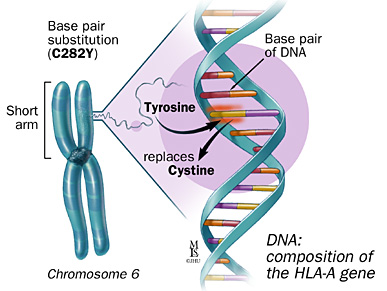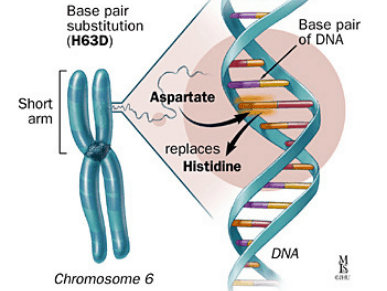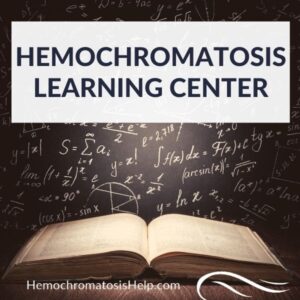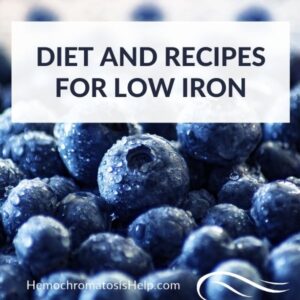What is Type 1 Hereditary Hemochromatosis?
Hereditary hemochromatosis is a genetic condition in which people absorb too much iron from their diet.
While iron is good for you in the proper amounts, the hemochromatosis gene may cause excess absorption of iron. Eventually, this increased iron absorption leads to iron overload.
There are several types of hemochromatosis, but type 1 hemochromatosis is the most common. Type 1 hemochromatosis is also commonly referred to as hereditary hemochromatosis or genetic hemochromatosis.
When we have hereditary hemochromatosis, part of our DNA has a variation that affects iron absorption from our diet.
Normally, iron metabolism is a tightly controlled system. Even slight elevations in iron above and beyond what the body uses or needs will send a signal to decrease the uptake and absorption of dietary iron.
With hemochromatosis, it is like the body always thinks it is deficient in iron.
What Causes Type 1 Hemochromatosis?
Type 1 hereditary hemochromatosis results from a genetic variation to the HFE gene on chromosome 6 and usually involves the C282Y and H63D alleles.
Don’t worry. I’ll explain what all of that means in a moment.
Genes and Alleles Defined
First, let’s talk about genes and alleles.
- Genes are made of DNA and serve as instructions for how the body produces specific proteins and carry out many essential functions.
- An allele is a form of a gene that has a slightly different DNA sequence from what is normally seen.
These different DNA sequences in our genes are what make us all unique.
For example, variations in alleles are what give people different traits such as eye color, hair color, and height.
Changes in alleles, however, can also lead to hereditary genetic medical conditions and diseases.
Inherited Genetic Mutations
We inherit our genes from our parents. If one of our parents has a genetic mutation (a permanent change in their DNA sequence), we may inherit a copy of that change from them.
If both parents have the same mutation, we could potentially inherit copies of the same mutation from both parents.
These inherited genetics result in DNA that is permanently changed and will be present for a person’s entire life.
Likewise, this genetic mutation may be passed down to the next generation.
This type of gene mutation is what we see from the hereditary hemochromatosis gene, also known as HFE.
What is the HFE Gene?
The naming of the hemochromatosis gene “HFE” stands for “High Iron.” Fe is iron’s chemical symbol, so when you put the H with the FE… you get the HFE gene.
The HFE gene makes a protein involved in iron absorption and causes the body to take in excess iron from food and water.
In healthy iron metabolism, this gene helps control and regulate how much iron absorbs into our system. There is a feedback loop that is supposed to tell the body to stop taking in iron once it has had enough.
In hemochromatosis, however, the HFE variations cause a signal that continually and perpetually tells the digestive system to absorb iron from our food. It’s like there’s no “off switch.”
Over time, this gene mutation leads to iron overload.
HFE Gene Mutations: HFE, C282Y, H63D… oh my!
Type 1 hereditary hemochromatosis most commonly results from a homozygous gene mutation or a compound heterozygous gene mutation, most commonly from the alleles C282Y and H63D.
What???
I know it sounds complicated. Let me explain.
First, let’s define homozygous, heterozygous, and compound heterozygous.
- A homozygous gene refers to two mutations of the same allele. This means that you have two copies of the changed gene, one from each of your parents.
- A heterozygous gene indicates there is one mutation of an allele. This means you have one copy of the problem gene, but another copy that’s normal.
- Since several alleles affect iron absorption, another possibility is you could have two different heterozygous mutations simultaneously. This means you have one copy from two different genes. When this occurs, an individual is known as a compound heterozygote.
Next, let’s talk a little bit about C282Y and H63D.
C282Y and H63D refer to the two changes to chromosome 6 that are most often seen in someone with hemochromatosis.
These replacements change the DNA so that the protein created by each gene is now incorrect and unable to function as it should, thereby impacting iron metabolism in the body and setting off the cascade that is hemochromatosis.


How HFE Genetics Impact Severity of Disease in Hemochromatosis
You may be wondering why all of this matters.
The severity of the disease, and the odds that someone with these genes will experience symptoms and have problems, are related to which type of gene mutation is present.
The most common and the form most likely to be severe is homozygous for C282Y. This is when someone has two copies of the most impactful genetic mutation, C282Y.
The scenario second most likely to be severe is compound heterozygous. This is when you have one copy of C282Y and one copy of H63D.
The final scenario is heterozygous for either C282Y or H63D. This means you have only one copy of only one of the genes. This is often (but not always) the least severe manifestation of the condition.
In summary:
- Homozygous–> 2 copies of C282Y. Most likely to be severe.
- Compound Heterozygous –> 1 copy of C282Y + 1 copy of H63D. Second most likely to be severe.
- Heterozygous –> 1 copy of C282Y (or 1 copy of H63D). Least likely to be severe.
Who Inherits Hereditary Hemochromatosis?
By the numbers, 1 in 200 people of Northern European descent have two genetic mutations of the HFE gene.
This statistic includes individuals homozygous for two copies of the C282Y gene, as well as those who are compound heterozygous (C282Y + H63D).
Additionally, the numbers tell us that 1 in 9 individuals of Northern European descent are carriers of one HFE gene.
This means that having a single hemochromatosis gene is very common!
A Single Hemochromatosis Gene May Still Lead to Symptoms
When a person’s genetic profile possesses two mutations of the C282Y HFE gene (as described above), their health is at risk from iron overload.
Without a doubt, the most severe cases of hemochromatosis are the result of these genetics.
But it is important not to dismiss the impact that one single hemochromatosis gene mutation can have on our health.
Even one changed copy of C282Y or H63D may lead to a degree of iron overload in some individuals. This scenario can absolutely be an underlying cause of health challenges, symptoms, illness, or disease for many people.
Many doctors, lab testing companies, books, and other websites tend to down-play the potential health consequences of having only one hemochromatosis gene.
You may read or hear that one variation of the gene is not “clinically relevant.”
However, this ignores the stories and symptoms of people whose health has been compromised by a moderate level of iron overload.
Many individuals from around the world have written to me and told me about their health challenges due to high iron even though they only have one gene mutation.
In fact, this is my experience with my own hemochromatosis story.
Likewise, I have heard numerous stories from people who did not understand their potential health risks or the implications of storing too much iron. I have seen countless cases in which individuals were told their health was fine, or that it was “all in their head.”
Perhaps worst of all is when a person is told by a doctor that they have a hemochromatosis gene, but that they do not need to do anything about it, because they only have one mutation.
I have even heard of stories where people were discouraged from donating blood, even a single time, even with elevated ferritin.
The fact is that you can exhibit symptoms of excess iron with only a single gene, and in some cases, without any gene mutation at all!
A fascinating review from the American Journal of Epidemiology found that 78% of people diagnosed with hereditary hemochromatosis are homozygous for C282Y.
This leaves 22% of individuals diagnosed with hereditary hemochromatosis with something other than having two copies of C282Y.
In this report, patients with other combinations of genetics (including 7% who had neither C282Y nor H63D!) still had iron overload symptoms and had been clinically diagnosed by a healthcare practitioner.
In this review:
- 5% were found to be compound heterozygotes (C282Y/H63D)
- 1.5% were homozygous for the H63D mutation (meaning they had two copies of H63D but no copies of C282Y)
- 3.6% were C282Y heterozygotes (meaning they had only one copy of C282Y)
- 5.2% were H63D heterozygotes (meaning they had only one copy of H63D and no copies of C282Y)
- 7% had no mutations of either C282Y or H63D
This means the patients with non-traditional genetics may experience symptoms and labs indicative of iron overload, even though they do not have the classically defined genetics of having two copies of C282Y.
As stated above, however, many doctors consider two copies of C282Y to be required for the diagnosis of hemochromatosis, leaving many patients with atypical genetics suffering but without diagnosis, support, or treatment options.
Hereditary Hemochromatosis Treatment
Fortunately for those with hereditary hemochromatosis who would like to “do something about it,” we are here to help!
If you know you have iron overload, why wait to see if you develop clinically relevant symptoms?
If hemochromatosis is identified early and effective treatments like therapeutic phlebotomy are well-tolerated, then you may be able to prevent symptoms and complications.
There are so many positives that can come from addressing hereditary hemochromatosis safely and effectively.
Reference:
E. H. Hanson, G. Imperatore, W. Burke. “HFE Gene and Hereditary Hemochromatosis: A HuGE Review.” American Journal of Epidemiology, Volume 154, Issue 3, 1 August 2001, Pages 193–206, https://doi.org/10.1093/aje/154.3.193

Would you like to read hemochromatosis success stories? Learn more here.

Would you like to learn more ways to help your hemochromatosis? Join our newsletter.




